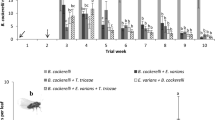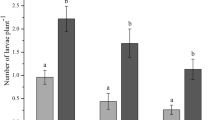Abstract
Field studies to assess the impact of Bacillus thuringiensis var. tenebrionis (Btt)-insecticides on Colorado potato beetle populations, egg survivorship and levels of predation on egg masses were conducted in replicated field research plots during two years. Stage-specific abundance of the Colorado potato beetle and predation on egg masses were monitored in Btt-treated and untreated potato plots in both years. The Btt-treatments significantly reduced densities of large (third and fourth instar) Colorado potato beetle larvae. The densities of large larvae remained below 0.5 and 3 per plant in the Btt-treatment while peak densities of 4.5 and 21 large larvae per plant occurred in the untreated control in 1992 and 1993, respectively. Regular sampling of egg masses indicated that predation rates in Btt-treated and untreated plots did not differ significantly although, in 1993, predation rates of up to 100% were recorded, only in Btt-treated plots. In a predator exclusion study carried out in 1992, survivorship of protected eggs was consistently higher than of eggs exposed to predation. Seasonal survivorship of exposed eggs was significantly lower in the Btt-treated than in untreated plots. Btt insecticides for control of Colorado potato beetles provided direct protection of the crop and were compatible with naturally-occurring biological control of Colorado potato beetle eggs due to predation.
Similar content being viewed by others
References
Ferro, N.D. and G. Boiteau, 1993. Management of insect pests. In: R.C. Rowe (ed), Potato Health Management, APS Press, St. Paul. pp. 103–115.
Ferro, N.D., Q-Ch. Yuan, A. Slocombe and A.F. Tuttle, 1993. Residual activity of insecticides under field conditions for controlling the Colorado potato beetle (Coleoptera: Chrysomelidae). J. Econ. Entomol. 86: 511–516.
Giroux, S., J.-C. Côté, C. Vincent, P. Martel and D. Coderre, 1994. Bacteriological insecticide M-One effects on predation efficiency and mortality of adult Coleomegilla maculata lengi (Coleoptera: Coccinellidae). J. Econ. Entomol. 87: 39–43.
Hanzlik, M.W., 1994. Cultural control of Colorado potato beetle and European corn borer in eastern North Carolina potato fields.MS Thesis, North Carolina State University, Raleigh, NC, USA.
Hare, J.D., 1990. Ecology and management of the Colorado potato beetle. Annu. Rev. Entomol. 35: 81–100.
Hazzard, R.V., D.N. Ferro, R.G. VanDriesche and A.F. Tuttle, 1991. Mortality of eggs of Colorado potato beetle (Coleoptera: Coccinellidae). Environ. Entomol. 20: 840–888.
Huynh, H. and L.S. Feldt, 1970. Conditions under which mean square ratios in repeated measurement designs have exact F-distributions. J. of the Am. Statistic. Ass. 65: 1582–1589.
Hilbeck, A., 1994. Ecological interactions of the Colorado potato beetle with its host plants and natural enemies in North Carolina. Ph.D. Thesis, North Carolina State University, Raleigh, North Carolina, USA.
Hilbeck, A. and G.G. Kennedy, 1996. Predators feeding on the Colorado potato beetle in insecticide-free plots and insecticide-treated commercial potato fields in eastern North Carolina. Biol. Control 6: 273–282.
Hilbeck, A., C. Eckel and G.G. Kennedy, 1997. Impact of predation on Colorado potato beetle eggs by generalist predators in research and commercial potato plantings. Biol. Control 8: 191–196.
Ignoffo, C.M. and C. Garcia, 1978. UV-photoinactivation of cells and spores of Bacillus thuringiensis and effects of peroxidase on inactivation. Environ. Entomol. 7: 270–272.
Marrone, P., 1993. Engineered plants and microbes in integrated pest management systems. In: L. Kim (ed), Advanced engineered pesticides, Dekker Inc., New York. pp. 233–247.
Perlak, F. J., T.B. Stone, Y.M. Muskopf, L.J. Peterson, G.B. Parker, S.A. McPherson, J. Wyman, S. Love, G. Reed, D. Biever and D.A. Fischhoff, 1993. Genetically improved potatoes: protection from damage by Colorado potato beetles. Plant. Mol. Biol. 22: 313–321.
SAS Institute, 1988. SAS/ETS user's guide: statistics, version 6. SAS Institute Inc., Cary, North Carolina.
Author information
Authors and Affiliations
Corresponding author
Rights and permissions
About this article
Cite this article
Hilbeck, A., Eckel, C. & Kennedy, G.G. Impact of Bacillus thuringiensis – insecticides on population dynamics and egg predation of the Colorado potato beetle in North Carolina potato plantings. BioControl 43, 65–75 (1998). https://doi.org/10.1023/A:1009966404802
Issue Date:
DOI: https://doi.org/10.1023/A:1009966404802




